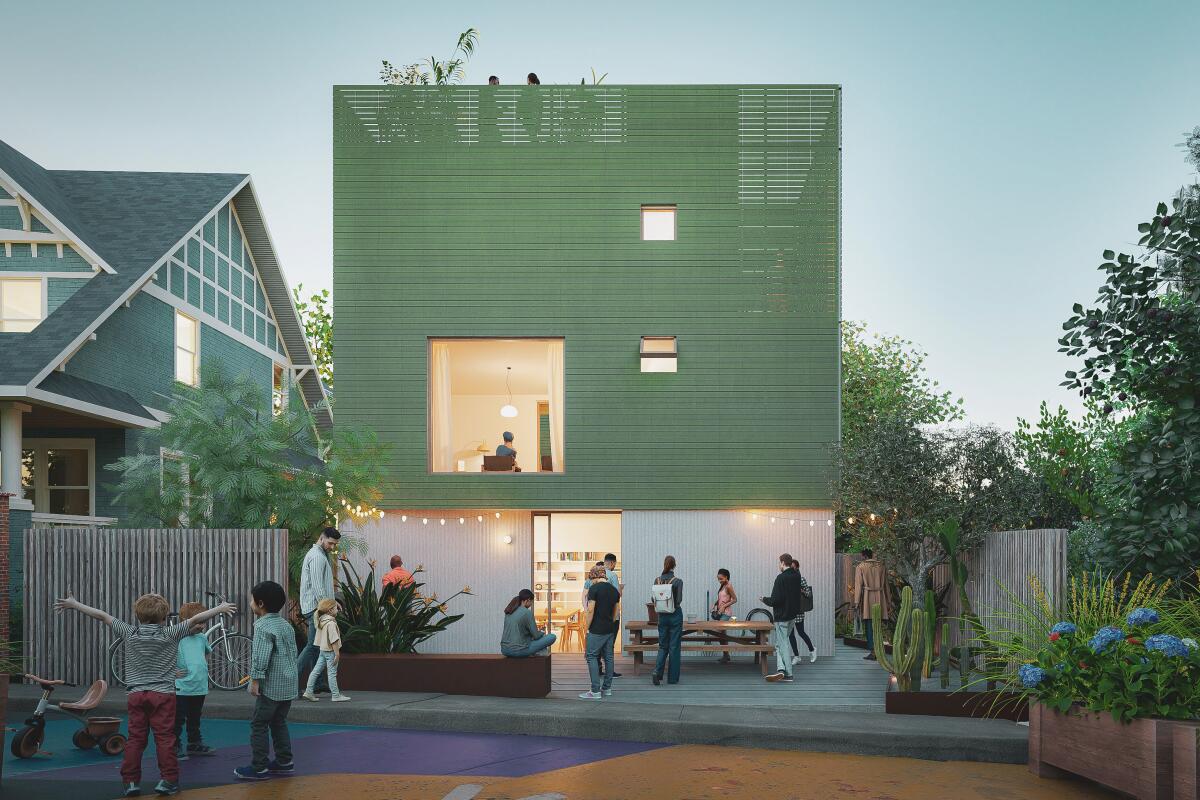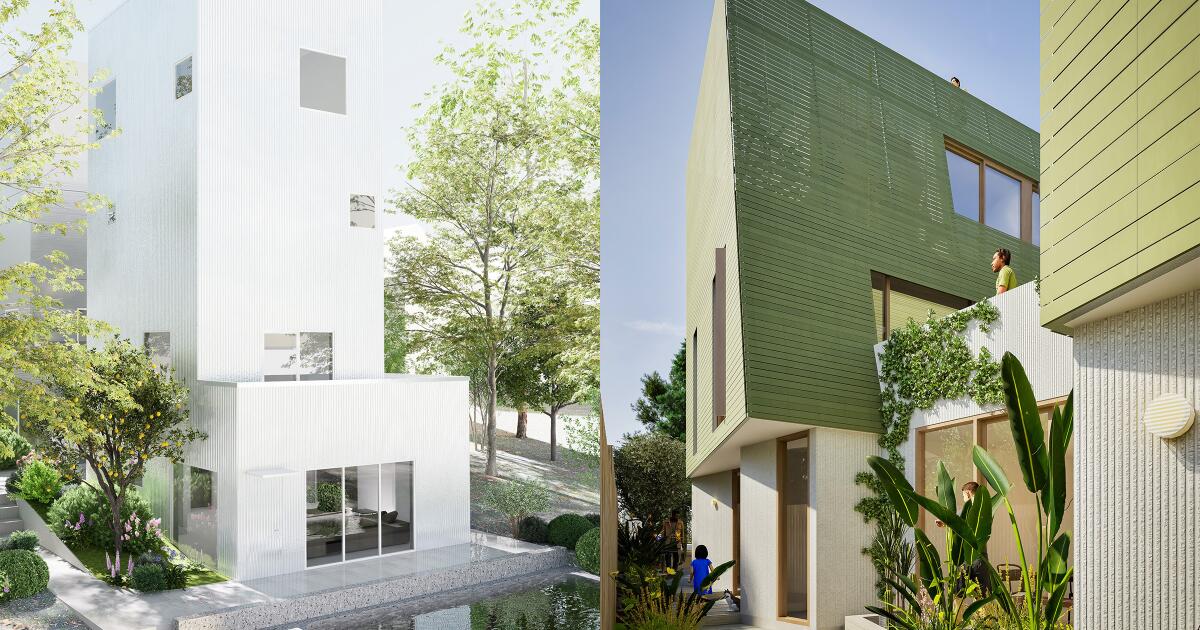Virtually because the first suburbs have been inbuilt Los Angeles, there have been worries that including density would “Manhattanize” L.A., rendering it so crowded with new vertical improvement as to be unrecognizable to longtime residents. Within the Nineteen Eighties, as battles over development heated up, one native slow-growth group dubbed itself Not But New York.
However Los Angeles has at all times been a metropolis with a knack for reshaping itself by seeking to its personal architectural previous. Specifically, medium-density designs resembling bungalow courts and dingbat flats have welcomed waves of newcomers for greater than a century whereas changing into architectural emblems of upward mobility and a very Southern Californian design sensibility — casual and optimistic.
We’ve got by no means wanted a return to that sort of improvement greater than now, within the wake of the Eaton and Palisades fires, whilst public dialogue has centered totally on rebuilding precisely what was misplaced. With affordability pressures as intense as ever, now could be the time to not Manhattanize however, as soon as once more, to Los Angelize L.A.
As longtime advocates for design excellence and insurance policies to spice up housing manufacturing, we imagine there’s nothing extra Angeleno than the reinvention of the so-called R1 neighborhood, the single-family zone that first emerged in L.A. with the Residential District Ordinance of 1908. R1 zoning shifted into overdrive in 1941 when tract homes emerged to exchange the bean fields of Westchester, close to what’s now Los Angeles Worldwide Airport.
It wasn’t till 2016, with the looks of a brand new state legislation permitting accent dwelling models, or ADUs, that the R1 neighborhood advanced in any significant means. Even essentially the most ardent champions of ADUs — aka granny flats or casitas — couldn’t have foreseen how broadly widespread they’d change into. As we speak, about one-fifth of recent housing permits in California and a whopping one-third within the metropolis of L.A. are ADUs.
Nonetheless, the granny flat is not any silver bullet. The housing affordability disaster in Los Angeles calls for a extra bold method than including new residential improvement one small unit at a time. State legal guidelines permitting as many as 10 flats on a single-family lot have been on the books for a number of years now. However householders and builders have been sluggish to reap the benefits of them, and plenty of California cities have dragged their toes in making them actually usable.
The end result has been a stalemate, with Los Angeles among the many cities struggling to take the essential step previous the ADU to start producing further missing-middle housing in actual quantity, whilst rents and residential costs proceed to climb. Town‘s Low-Rise LA design problem was organized in 2020 to assist break this logjam. Most of the winners included design classes clarified by the COVID-19 pandemic, after we realized that second, third and fourth models in R1 zones may provide not simply rental revenue or an additional bed room however the flexibility to quarantine or work at home whereas constructing stronger ties with prolonged household and neighbors.
A brand new initiative — Small Tons, Massive Impacts — organized by cityLAB-UCLA, the Los Angeles Housing Division and the workplace of Mayor Karen Bass builds on Low-Rise LA with a concentrate on growing small, typically neglected vacant heaps, of which there are greater than 25,000 throughout the town, in keeping with cityLAB’s analysis. The purpose is simple: to exhibit a spread of ways in which Los Angeles can develop not by aping the urbanism of different cities however by producing extra of itself.

Totally different views of the “Mini Towers Collective” and the “Shared Steps” proposals. Each favor shared outside area balanced with particular person architectural identification. (courtesy of cityLAB UCLA)
Winners of this design competitors, introduced on the finish of Could, positioned six or extra housing models on a single web site, typically dividing it into separate heaps. One proposal created rowhouses, barely cracked aside to establish particular person houses and entrances as they cascade alongside an irregular web site. A communal yard opens to the road in one other venture, with roof gardens between separated, two-story houses atop ADUs that may be rented or joined again to every of a number of most important homes on the location. Different designs present that vertical structure, within the type of good-looking new residential towers from three to seven tales, can comfortably coexist with L.A.’s low-rise housing inventory when the design is considerate sufficient.
A key purpose of the competitors was to provide new fashions for homeownership. When land prices are subdivided and parcels constructed out with a set of compact houses, together with models that may produce rental revenue or be bought off as condos, a special method to housing affordability comes into focus. Those that have been shut out of the housing market can start to construct wealth and contribute to neighborhood stability.
The standard R1 paradigm, along with limiting housing quantity, suffers from a inflexible, gate-keeping form of logic: In case you can’t afford to purchase or lease a whole single-family house in an R-1 L.A. neighborhood, that a part of city is inaccessible to you. Most of the successful designs, against this, create compounds versatile sufficient to accommodate a spread of phases in a resident’s life. In a single improvement, there could also be models good for single occupants (a junior ADU), younger households (a ground-level unit with a personal yard), and empty-nesters (a house with a rooftop backyard). As with the granny flat mannequin, building can proceed in phases, with models added over time as circumstances dictate.
Having served on the Small Tons, Massive Impacts jury, we see indicators of hope in its rendering of L.A.’s future. The true proof lies within the initiative’s second section, set for later this yr, when the town’s Housing Division will difficulty an open name, based mostly on the design competitors, to developer-architect groups who will construct housing on a dozen small, city-owned vacant parcels, with tens of hundreds of privately owned infill heaps able to observe go well with. If the successful schemes are constructed, Los Angeles will as soon as once more exhibit the attraction and resiliency of its architectural DNA. Manhattan: Eat your coronary heart out.
Dana Cuff is a professor of structure, director of cityLAB-UCLA and co-author of the 2016 California legislation that launched ADU building. Christopher Hawthorne, former structure critic for The Occasions, is senior critic on the Yale College of Structure. He served underneath Mayor Eric Garcetti as the primary chief design officer for Los Angeles.

